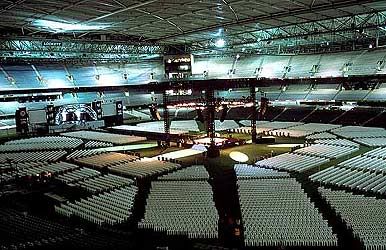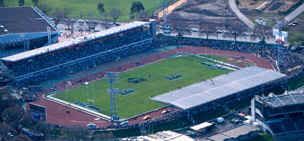Errinundera's NSWC Football Grounds
Contents
Football Grounds
The Amphitheatre
- Location: Big Tree Camp
- Capacity: 20,000
- Notable Feature: Semi-circular with panoramic views
Just outside Big Tree Camp is the spectacular Big Tree Camp Amphitheatre, home to the Monkeytop United Football Club. It is not actually a stadium as such. From the outskirts of Big Tree Camp the Rodger River valley falls away quite steeply. A gigantic stone amphitheatre has been constructed on one particularly steep section. At its base there is a flat area just large enough for a football pitch. 20,000 people can sit in an arc around the pitch while the players’ facilities are mined into the hillside under the ampitheatre. Like the Milosis Coliseum in McKillops Bridge and the Downfall Stadium in Errinundera, splendid views form a backdrop to the football action. But, whereas the other 2 stadia are only open at the ends, the Amphitheatre is half a circle. Quite simply, the outlook is vast.
Floating: that is the oft-used word to describe the heady experience of a visit here.
</div>The B.C.G. (Bonang Cricket Ground)
- Location: Bonang
- Capacity: 101,000
- Notable Feature: Home of the Gonads
Bonang confidence in its footballing future is reflected in the city’s decision to build the largest stadium in the nation: the 101,000 seat Bonang Cricket Ground. The stadium consists of two great semi-circular stands built and designed by competing companies.
Why that name? The ground’s primary use for over a hundred years has been as a cricket ground. It will continue to be used as such in summer although the few thousand that attend cricket matches will be dwarfed by the stands.
The mayor of the city, kirnerj, had the World Cup in mind. “We saw this as a chance to stage something of a coup. No other city in Errinundera has the resources to build anything to match it.” She is absolutely correct: the biggest matches will be held at the stadium.
The B Triple R (Bemm River Recreation Reserve)
- Location: Bemm River
- Capacity: 35,000
- Notable Feature: Built in the middle of the river
LIke so many cities, towns and structures in Errinundera, The Bemm River Recreation Reserve takes advantage of its natural environment. Built on an island in the centre of the river, the stadium expanded over the years so that, now, no trace of the island is visible from the riverbanks. The football ground gives the illusion of rising out of the river itself. Indeed the B Triple R, as it is affectionately called, can only be accessed via skywalks that bring the fans into the stadium through its roof. Someone canoeing down the river may think they are in a pristine wilderness until they round a bend in the river and see graceful parabolic fingers stretching from all directions out of the tree canopy and meeting at the admittedly rather ugly edifice in the middle of the river.
The B Triple R was one of the first large stadiums built when football was introduced to Errinundera and has therefore been well and truly overtaken by later developments. A new stand has increased the capacity to 35,000 and facilities, while not bad, are only adequate.
</div>The Cavern
- Location: Mount Ellery
- Capacity: 52,000
- Notable feature: Undergound, below 3,000m Mount Ellery
In order to not fall behind its rival cities in the Errinundrian Football Association, the City of Mount Ellery decided to build the largest and most modern football ground in the nation. At the time the largest ground was the 32,000 seat Frosty Hollow Stadium. Clearly, something of this order of magnitude could not be built on the outside of the mountain but, equally clearly, the engineering challenges in building it underground were daunting. A 52,000 seat capacity ground was calculated as the largest practicable and a seven-year excavating and furbishment program was anticipated. Sadly for the ambitions of the Mountain Folk, Bonang and First Creek Falls have since completed larger stadiums.
The major advantage of an underground stadium is obvious: weather has no effect on the games. In winter the temperature outside can be minus twenty degrees Celsius but patrons will be snug and warm away from any blizzards in an environment where the temperature varies by less than 2 degrees all year round. Similarly in summer, there is no trace of the hot north wind that can bedevil the nation.
In typical Errinundrian bloody-minded fashion, the local administration is determined to have a natural grass playing surface. This has created considerable difficulties. The solution is to suspend enormous sun lamps from the ceiling that, during daylight hours when the ground is not being used, are lowered to only one metre above the grass. Automatically computer controlled, the lights imitate exactly the brightness and wavelength of light falling on a particular chosen spot in the outside world.
</div>Flatlands
- Location: Waratah Flat
- Capacity: 21,000
- Notable Feature: none really
Frosty Hollow
- Location: Rooty Break
- Capacity: 45,000
- Notable Feature: Sunken pit with giant forest up to edge
In the early days of NSWC Frosty Hollow was the designated national stadium and the official ground for all Errinundera’s home games during qualifying. Located on the outskirts of Rooty Break, it is the home ground of Rooty Break and, formerly, First Creek Falls. When FCF relocated to the Downfall Stadium the Rooty Break club decided that a major overhaul of the stadium was required if they were to continue to host international matches.
Like the B Triple R in Bemm River, fans enter the stadium through its roof. The two stadia, however, could hardly be more dissimilar. Located on the Errinundera Plateau, Frosty Hollow is well and truly landlocked. The notable thing about the arena is that, instead of being built above ground, a gigantic pit was excavated into the ground. All the while, the constructors took great care not to damage the gigantic trees that grow right up to the edge of the stadium. "Errinundera is forest and forest is Errinundera," explained construction manager, eservat, at the time, "and so the idea is for these magnificent trees to utterly dominate the view from inside the stadium. The outside edge of the roof is only half a metre above the surrounding ground. From inside, what you will see is the illusion of a forest growing out of the roof. The largest trees are over 120 metres high and have a diameter of nearly 20 metres. Compare this with the height from the playing surface to the roof, which is about 70 metres. We aim to give the impression of being in the very heart of the forest."
Frosty Hollow is notorious for its weather: fog, severe frost, lightning, snow storms. Home games against Errinundera's most bitter rivals are usually scheduled here.
Milosis Coliseum
- Location: McKillops Bridge
- Capacity: 41,000
- Notable feature: clifftop stadium with panoramic views
Sixty metre granite cliffs dominate the western bank of the Snowy River in McKillops Bridge. The unusual feature of the McKillops Bridge Coliseum is that the pitch goes almost to the edge of the cliff affording a dizzying view for players and spectators alike. Fans in the top row seats can see far into the east of Errinundera. A secure mesh fence prevents people and players from falling over the edge. The ground is the home of the struggling side Milosis (The White Guard) and, much to the chagrin of the upper city folk, has become a sort of permanent temporary home to powerful 1st division side McKillops Bridge (The Kingfishers) which has its support among the lower city folk.
The Kingfishers are currently the nation's premier league champions and thus their team colours are the national side's alternative strip.
National Downfall Stadium
- Location: First Creek Falls
- Capacity: 64,000
- Notable Feature: 50m Hairy Man Falls dominates one end
The EFA decided to build the National Downfall Stadium outside the capital city as a showpiece combining the beautiful game with the natural environment. To meet this goal the stadium was erected lower down the escarpment on a spot that was severely degraded by prospectors over a hundred years ago. The location, known as Downfall, is at the base of one of several waterfalls and cataracts downstream from First Creek Falls.
With grandstands only along the sides of the pitch, the gap in the northern end of the arena is dominated by the 50-metre waterfall that seems to fill it entirely. The gap in the southern end looks down the Errinundera River Valley towards Bemm River. At night the lights twinkling from between the trees in Bemm River are visible from the stadium. A cable car system connects the stadium to the nearby First Creek Falls which cannot be seen from the ground.
There were initial concerns that the shape of the stadium would create a wind tunnel. Extensive tests have allayed these fears. The escarpment above the ground and the steep ridges on either side create a pocket of still air. Spectating here is a memorable experience.



